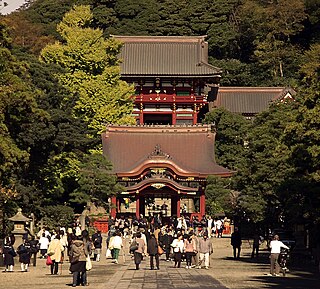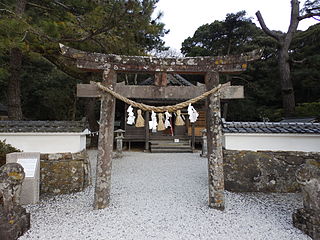
Emperor Ōjin, also known as Hondawake no Mikoto (誉田別尊) or Homuta no Sumeramikoto (譽田天皇), was the 15th Emperor of Japan, according to the traditional order of succession. Both the Kojiki, and the Nihon Shoki record events that took place during Ōjin's alleged lifetime. Ōjin is traditionally listed as the first emperor of the Kofun period, and is primarily known for being the controversial son of Empress Jingū. Historians have mixed views on his factual existence, if Ōjin was indeed a historical figure then it's assumed he reigned much later than he is attested.

In Japanese religion, Yahata formerly in Shinto and later commonly known as Hachiman is the syncretic divinity of archery and war, incorporating elements from both Shinto and Buddhism.

Empress Jingū was a legendary Japanese empress who ruled as a regent following her husband's death in 200 AD. Both the Kojiki and the Nihon Shoki record events that took place during Jingū's alleged lifetime. Legends say that after seeking revenge on the people who murdered her husband, she then turned her attention to a "promised land". Jingū is thus considered to be a controversial monarch by historians in terms of her alleged invasion of the Korean Peninsula. This was in turn possibly used as justification for imperial expansion during the Meiji period. The records state that Jingū gave birth to a baby boy whom she named Homutawake three years after he was conceived by her late husband.

A Shinto shrine is a structure whose main purpose is to house ("enshrine") one or more kami, the deities of the Shinto religion.

Ikuta Shrine is a Shinto shrine in the Chūō Ward of Kobe, Japan, and is possibly among the oldest shrines in the country.

Tsurugaoka Hachimangū (鶴岡八幡宮) is the most important Shinto shrine in the city of Kamakura, Kanagawa Prefecture, Japan. The shrine is a cultural center of the city of Kamakura and serves as the venue of many of its most important festivals with two museums.

Shinbutsu-shūgō, also called Shinbutsu shūShinbutsu-konkō, is the syncretism of Shinto and Buddhism that was Japan's main organized religion up until the Meiji period. Beginning in 1868, the new Meiji government approved a series of laws that separated Japanese native kami worship, on one side, from Buddhism which had assimilated it, on the other.
Azumi-no-isora is a shinto kami of the seashore. He is considered to be the ancestor of the Azumi people. He is worshiped at a number of shrines, including Mekari Shrine (和布刈神社) of Kitakyushu, Shikaumi Shrine on Shika Island, and Shiga Shrine (志賀神社) of Tsushima.
Sumiyoshi sanjin (住吉三神) is the generic name for the three Shinto gods Sokotsutsu no O no Mikoto (底筒男命), Nakatsutsu no O no Mikoto (中筒男命), and Uwatsutsu no O no Mikoto (表筒男命). The Sumiyoshi sanjin are regarded as the gods of the sea and sailing. They are sometimes referred to as the Sumiyoshi daijin (住吉大神).

Usa Jingū (宇佐神宮), also known as Usa Hachimangū (宇佐八幡宮), is a Shinto shrine in the city of Usa in Ōita Prefecture in Japan. Emperor Ojin, who was deified as Hachiman-jin, is said to be enshrined in all the sites dedicated to him; and the first and earliest of these was at Usa in the early 8th century. The Usa Jingū has long been the recipient of Imperial patronage; and its prestige is considered second only to that of Ise.

Kagoshima Shrine is a Shinto shrine located in Kirishima, Kagoshima prefecture, Japan. One of the 2,861 shrines listed in the Engishiki, it is the first shrine in the historic Osumi Province. It is dedicated to Hoori, Toyotama-hime, Emperor Chūai, Emperor Ōjin and Empress Jingū. It is classified as a Beppyo shrine, according to the Association of Shinto Shrines. Historically it was also known by the names "Osumi Sho Hachimangu" and "Kokubu Hachimangu".

Until the Meiji period (1868–1912), the jingū-ji were places of worship composed of a Buddhist temple and a Shintō shrine, both dedicated to a local kami. These complexes were born when a temple was erected next to a shrine to help its kami with its karmic problems. At the time, kami were thought to be also subjected to karma, and therefore in need of a salvation only Buddhism could provide. Having first appeared during the Nara period (710–794), jingū-ji remained common for over a millennium until, with few exceptions, they were destroyed in compliance with the Kami and Buddhas Separation Act of 1868. Seiganto-ji is a Tendai temple part of the Kumano Sanzan Shinto shrine complex, and as such can be considered one of the few shrine-temples still extant.
Tamayori-hime is a goddess in Japanese mythology. Her name is spelled as 玉依毘売命 in the Kojiki and 玉依姫 in the Nihon Shoki.

Yusuhara Hachiman-gū (柞原八幡宮) is a Shinto shrine located in the city of Ōita, Ōita Prefecture, Japan. It is one of two shrines claiming the title of ichinomiya of former Bungo Province, the other being the Sasamuta Jinja, also in Ōita. The shrine's main festival is held annually on March 15. It is also cometimes refrred to as Yusubara Hachiman-gū (由原八幡宮).
Tsubonuma Hachiman Shrine is a Shinto shrine located in Sendai, Miyagi Prefecture, Japan. It is a Hachiman shrine, dedicated to the kami Hachiman as well as to Emperor Ojin, Empress Jingū, Emperor Chūai, and Takenouchi no Sukune.
Fukuyama Hachimangū is a Shinto shrine located in Fukuyama, Hiroshima Prefecture, Japan. It is a Hachiman shrine, dedicated to the kami Hachiman. The kami it enshrines include Emperor Ōjin, Empress Jingū, and Himegami (比売神).
Fuyo Jingū was a planned Shintō shrine in Buyeo. It was intended to help with the Japanese occupation of Korea and to be ranked as a Kanpei-taisha. Construction started in 1939 but was never completed. It was highly significant in propaganda with many describing it as the second Shintō capital after Ise Grand Shrine.

Watatsumi Shrine is a Shinto shrine located in Tarumi-ku, Kobe. It is said to have been founded by the legendary Empress Jingu. It is one of the three major shrines of Harima Province. It has a festival on October 11.

Shikaumi Shrine is a Shinto shrine located in Fukuoka, Kyushu, Japan. It is located on Shikanoshima island.

Watazumi Shrine, also known as Watatsumi Shrine is a shinto shrine in Tsushima, Nagasaki.

















